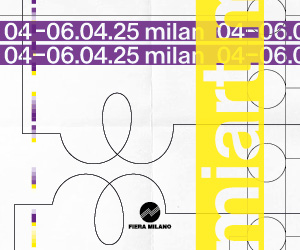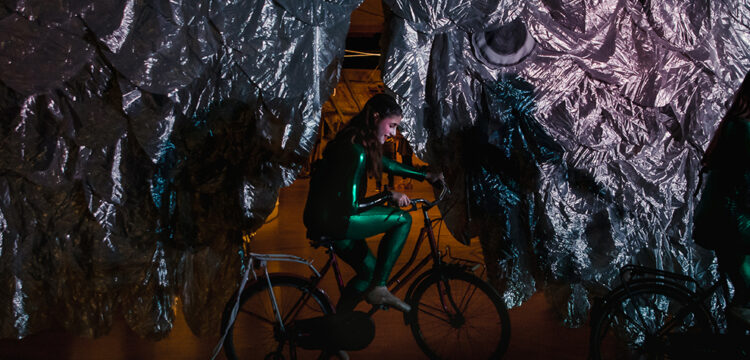How To Handle The Past
…that has shaped our knowledge: “The Teacher” by Agnes Scherer
Agnes Scherer’s The Teacher is an elaborate theatrical performance that mobilizes paintings, puppetry, sculpture, stagecraft, music and lyrics in the tradition of the Gesamtkunstwerk. It was presented again in Bologna during ART City 2023, at Teatri di Vita Sala Studio. It was performed by Soya Arakawa, Claudia Barth and Tobias Textor.
In our last conversation, while looking back at the genesis of The Teacher, Agnes Scherer told me how this work is inspired by the most rudimentary forms of theater. As she spoke, I began to think of late nineteenth century French theater, of the first futurist and Dadaist performances in which plastic and visual arts cross over into other disciplines, finding a space for experimentation on the stage. I immediately interpreted that “rudimentary” as the intentional sabotage of the history of the theater undertaken by various protagonists of the historical avant-gardes, but I was wrong.
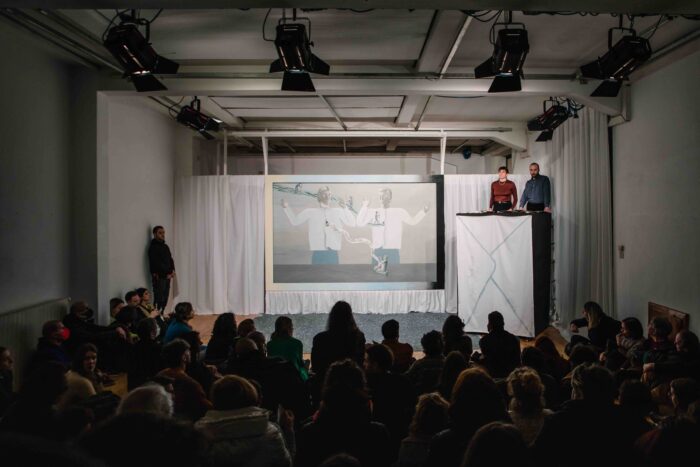
Scherer told about her first visit to Prague, and in particular to the Astronomical Clock, one of the city’s main tourist destinations where, on the stroke of the new hour, a still perfectly functional mechanical system allows the operation of a series of figures. Some appear and disappear behind special windows of the building, others are always visible, and move, generating ringing sounds. A medieval creation, it is a staging system that celebrates religious tributes, from the apostles to Jesus in the case of Prague, from the Magi to the Madonna with the Child in the model that overlooked Piazza Maggiore in Bologna between 1451 and 1796.
What fascinates Scherer about these short scenes is the narrative functioning which is mainly based on the alternating experience of “appearance” and ”disappearance”. A simple choreography which, playing on the level of presence, simulates the essence of any story: the twist. In a seminal text on the theory of narration, Jerome Bruner, referring to Aristotle, mentions the peripeteia (unforeseen) as the key element of a story, the one that allows it to unfold by interrupting the simple flow of events. The author comes to argue in a lapidary way that “for there to be a story, something unexpected must happen, otherwise ‘there is no story’.”
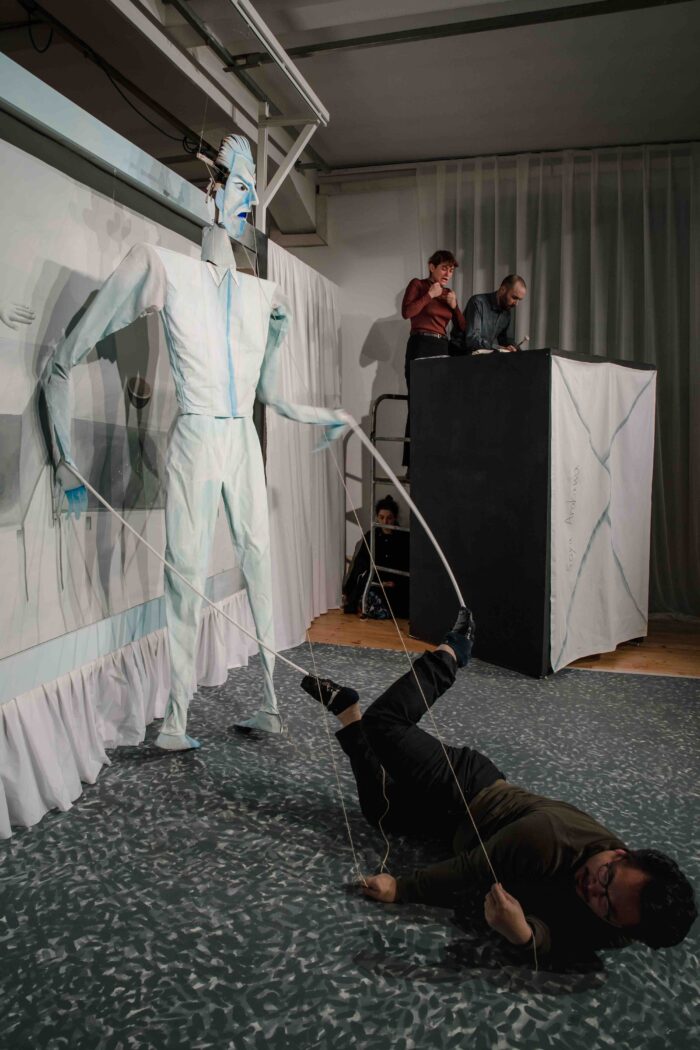
As the artist suggests, a similar form of rudimentary theater can be found nowadays in the use of PowerPoint to support public interventions and school lessons, during which the speakers perform in front of a succession of visual, textual, and sound contents that amplify their discourses. The advent of this communicative method, based on the progressive presentation of information, seems in fact to transform a lesson into a theatrical piece characterized by an elementary structure, not so dissimilar to the functioning of medieval clocks.
Scherer translates these scenic structures and rudimentary narrative mechanisms by structuring The Teacher as a chain of sudden apparitions, in which all the elements that make up the scene participate in intensifying its perception. It will later be seen how the dialectic of appearance/disappearance is also exploited by Scherer from a linguistic point of view, as a rhetorical form of dissemination of “truth” and of knowledge.
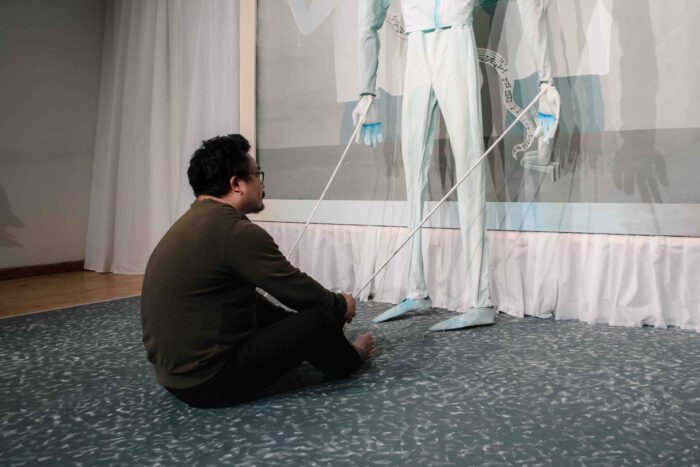
The Teacher is structured as a lesson rendered in the form of a didactic operetta, the second created by the artist. The epicenter of the performance is the puppet of a teacher who enters the scene via a ceiling track, dragged out from backstage by two assistants. Soya Arakawa, artist and performer, sits on the ground facing the “master”, fixing two sticks to his feet which will allow him, together with a series of strings, to control the teacher’s movements. As soon as Arakawa starts to move, the teacher reflexively starts his lesson. A series of assertive phrases are intoned by Claudia Barth who screams, distorts her voice at times by clapping her hands to her chest and amplifies it at other moments with the aid of a cardboard tube. At her side, on a stage overlooking the audience and the teacher, the lesson is punctuated by metal percussion performed by Tobias Textor who, following the pounding repetitiveness of Metal, electronic, and techno music, plays a series of Chinese opera gongs using them lying on a surface instead of hanging vertically. Behind the professor, a series of twelve paintings follow each other at short intervals, appearing and disappearing. Conceived as diagrams to support the invective, in some cases they recall scenes of transmission of knowledge or become actual illustrated demonstrations, in others they reveal the violence of didactic staging showing students-automata transformed into school desks.
By staging a constant narrative climax, the lesson entertains the audience through continuous visual, audio, and verbal twists and turns, until the conclusion in which, once the teacher has left the stage, a sarcophagus depicting Arakawa is taken from Barth’s and Textor’s stage, covering the performer’s body. Fossilized with one arm raised, as if to refer to an eternal belonging to his master, Arakawa suddenly comes out of a side trapdoor. While he now observes himself in the form of a sculpture, he emits a last call as if to refer to a rebirth or the first sprout of revolution.
The Teacher generates a particular tension that keeps the audience captivated in an atmosphere of euphoria, dismay, and disorientation. The blows delivered by the words, the breathless and engulfed gestures of the performers and the continuous beating of the percussion stun the spectators by generating a sort of shock wave, capable of making the time and space of the performance denser, faster, and more pressing.
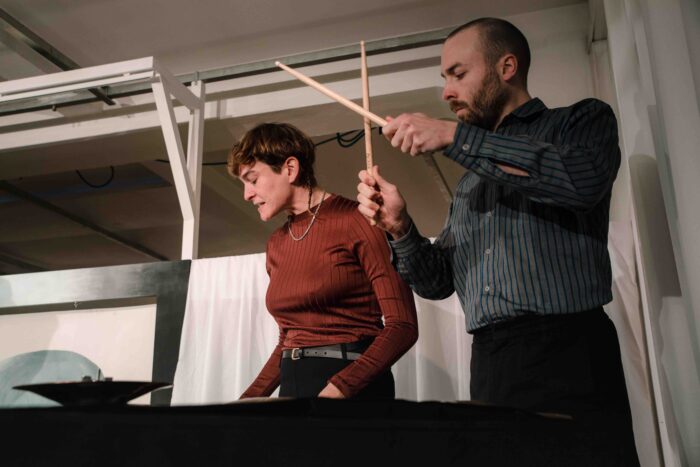
Scherer also explains the fundamental participation of the three performers, the only possible executors of the work, not only on a technical level but due to the affinities with their research path. In several works, Arakawa has questioned the figure of the “master” with performative actions that aimed to weaken or exorcize this figure. Claudia Barth, performer and activist, has repeatedly addressed the power relations that determine social and territorial organization. Tobias Textor creates sonic atmospheres combined with percussive accentuation to build transitions that play with the listeners’ expectations, employing elements from popular music and touching genres such as electronic, orchestral, ambient, noise and black metal music.
A central function within the work is exercised by the text of 12 the lessons composed by Scherer, recovering from her own memory a series of admonitions, advice, and false truths received from her “masters” during the years of education. “If you think you understood it, you didn’t understand it!” he opens the speech by immediately emphasizing the minority position of the public. The exclamation, like others during the lesson, collapses on itself without providing explanations, simply aiming to weaken the listener’s convictions and underline—formally unjustified—the position of wisdom. The teacher gives suggestions to learn new knowledge which, one sentence after another, however come into contradiction.
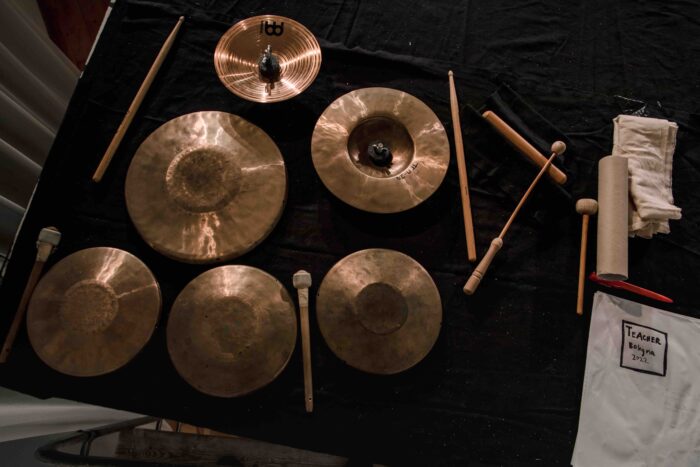
Scherer stages a parody of the power relationship between popularizers-teachers-leaders and their audience by revealing the rhetorical tools of their eloquence. Here the previously described system of appearance and disappearance returns central, showing itself as a method for strengthening the rhetorician’s position. Every sentence uttered seems to promise a truth that disappears a second after having pronounced it in a process that simply aims to convince the public of the superiority of the speaker who, once acquired, remains untouched even in the face of obvious paradoxes. Thus, the teacher seduces his students by leveraging their feelings and sensations, just like when, during the performance, the sentence explodes loudly: “Your weaknesses have always been strengths in reality and you have been chosen for a prize from the very beginning.”
An escape from this power relationship seems to be offered by Scherer by carefully observing the paintings that flow behind the scene during the performance. Their subjects seem to be the result of dreamlike apparitions, which can only be partially interpreted through the historical lens of Surrealism. While she talks to me about it, she tells me about a series of pencil works made between 2015 and 2019, produced through a free and unplanned drawing process. They too, like the paintings, present human figures associated with oversized objects, in which the academic rules of representation give way to a technical freedom that finds more inspiration from the subcultures of the seventies and the illustrations of comics than from the teachings of one’s masters. Technically, this approach is evident from the way Scherer uses gradient shading—one of the stylistic features that most distinguishes her painting—which, instead of following the usual relationship between light and planes, is employed spontaneously to enter into contrast with the backgrounds, bring out the subjects, give them physicality.
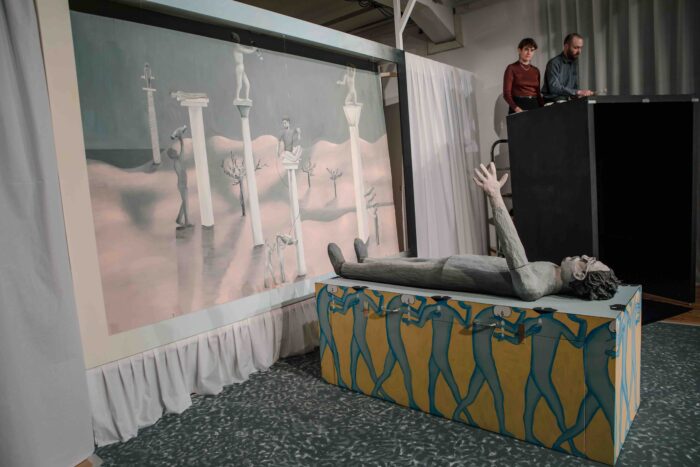
Concluding our call, we come to think of a “cultivated naivetè” as an artistic form and choice that reworks the lessons of the masters to detach themselves from them and build their own proxemics. An attitude that the philosopher John Dewey, in a key text on education (Experience and Education, 1938), associates with the questioning of one’s own experience which is ”already overlaid and saturated with the products of the reflection of past generations and by-gone ages. It is filled with interpretations, classifications, due to sophisticated thought, which have become incorporated […].”
In Experience and Nature, 1925, Dewey also argues: “We cannot permanently divest ourselves of the intellectual habits we take on and wear when we assimilate the culture of our own time and place […] We cannot achieve recovery of primitive naïveté. But there is attainable a cultivated naïveté of eye, ear and thought, one that can be acquired only through the discipline of severe thought.”
In this case “the discipline of severe thought” is understood by Dewey as a philosophical practice, all but naive, which seeks the origins of experience starting from the comparison with the world of childhood. In our case, Dewey’s position becomes essential because it constructs a theoretical horizon within which artistic practice can become one of the critical tools through which to handle the past that has shaped our knowledge.


